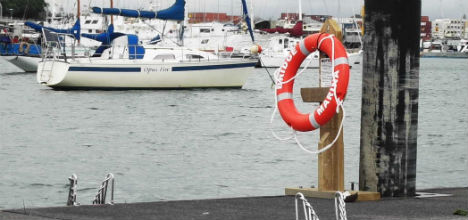Five separate water rescues in one day has prompted police to issue a warning for those heading out on the water.
Senior Sergeant Dave Litton says the first job came in at Raglan’s boat ramp at Manu Bay about 9.20am on Tuesday, when a 12-15 foot boat capsized in rough conditions putting three people into the water.
“All three people, who were all wearing life jackets, were able to swim to shore and a number of surfers in the water at the time ensured they made it safely.
“The trio were treated on the shore by attending ambulance staff for cuts and bruises.”
Dave says the next water rescue took place at Pauanui about 2.20pm and involved a large boat that lost power to its engine and was reported to be on fire and taking on water.
“There were four people aboard the vessel which was about 500m off shore. Fortunately it was well equipped with life jackets and communications equipment and the occupants abandoned ship into a dingy after raising the alarm both by cell-phone and radio.
“In a response coordinated by Police Search and Rescue, the Coastguard, local surf club and volunteer fire brigade all responded and the fire was able to be contained and the boat was able to make it to shore shadowed by a Coastguard vessel.”
Dave says the Pauanui incident highlighted the importance of having the means to communicate with emergency services should your vessel get into difficulty.
“Later jobs included responding to ambulance staff requiring assistance at Raglan’s Ocean Beach about 3pm where an overseas tourist pulled an Asian man out of the surf who had gotten into difficulty in a rip after rescuing two children, including his own son, from the water.
“The man was semi-conscious when emergency services arrived and the beach was cleared to allow a helicopter to land and take him to Waikato Hospital in a status two condition. This incident highlights the importance of swimming between the flags and the excellent work done by the overseas visitor.”
At about 4pm fire-fighters were called to assist a man in a homemade boat who got into difficulty on Tairua Harbour when he got his leg trapped in his wooden boat.
“The man had asked for fire-fighters to bring a chainsaw and his boat was assisted to shore where the man was freed.”
Dave says while each of these jobs had successful conclusions a major inter-agency response to reports of a missing Australian tourist out in a boat off Colville left responders scratching their heads in frustration.
“This man left Otautu Wharf in a 7ft aluminium dingy that was equipped with oars but no motor about 11.40am. At the time there was a 20 knot north westerly wind and a 1m northerly swell.
“Although wearing a life jacket, the man had not told anyone where he was going or when he would return and he had no communication equipment. After he had been gone about three hours his family became concerned and raised the alarm.”
The Coastguard launched a fixed wing aircraft from Auckland while the Police’s Eagle Helicopter was also called in to assist and two Coastguard vessels were put on standby.
“The man was located by the Eagle Helicopter sun bathing on a beach at Tiriteka Point, a bay north of Otautu Wharf and told the crew he was waiting for the tide to lift before returning.
“If this man had only told other people where he was going and had a cell-phone with him the valuable time and resources deployed in the search for him would not have been wasted.”
Dave urges people intending to enjoy recreation out on waters to take some simple steps to protect themselves and avoid first responders being called out needlessly.
*If going swimming at the beach, swim at beaches patrolled by life guards and swim between the flags.
*When boating, ensure your boat is equipped for the conditions, that there are life jackets for all occupants and that they wear them.
*Carry at least two forms of communication which should include a cell-phone, a hand held VHF radio on channel 16 or distress beacons including PLBs (personal locator beacons) or EPIRBs (emergency position-indicating radio beacons).
*Tell people when and where you are going, when you should be returning and when the alarm should be raised should you not return.



0 Comments
Leave a Comment